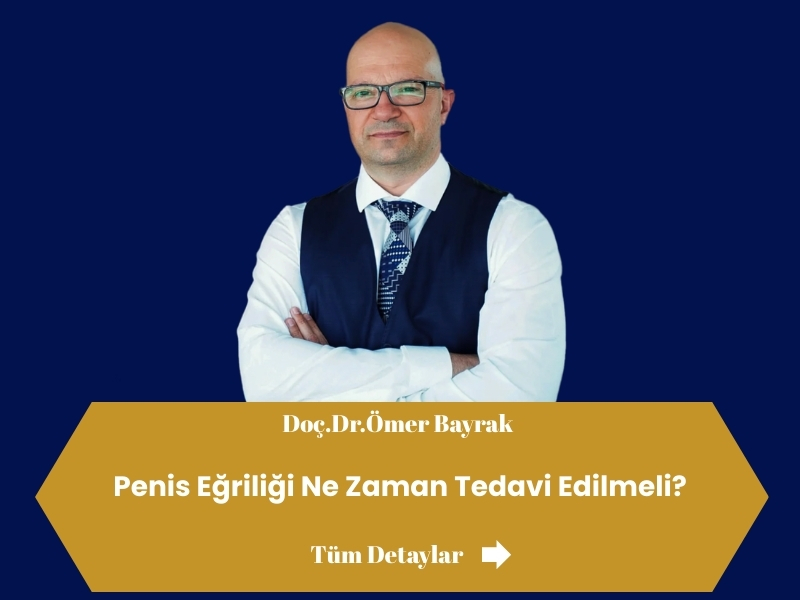Curvature of the penis, medically known as Peyronie’s disease is a condition caused by hard plaques that develop in the penile tissue. As long as the curvature is mild and does not interfere with sexual intercourse, it does not always require treatment. However, in advanced cases, it can cause pain, difficulty in sexual intercourse and psychological discomfort. My experience as a physician shows that treatment started at the right time gives more successful results both functionally and aesthetically. In this article, we will explain in detail in which cases penile curvature should be treated, the importance of early intervention and the solution methods offered by modern medicine.
Symptoms and Diagnosis of Penile Curvature
Penile curvature is a condition that is usually noticed during erection and occurs when the penis curves significantly upwards, downwards, to the right or to the left. In some patients, this curvature is mild, while in others it may be severe enough to prevent sexual intercourse. The most common symptoms are:
- Curvature or bending of the penis during erection
- Sensation of a hard plaque or mass on the penis
- Pain during erection
- Difficulty or dissatisfaction during sexual intercourse
- Decreased erection quality
The diagnostic process begins with a detailed history and physical examination. If necessary, penile ultrasonography is used to assess the location, size and hardness of the plaques. In some cases, special tests may be performed, especially to measure erectile function. Accurate diagnosis is critical in determining both the degree of curvature and the treatment method. In patients who present at an early stage, appropriate treatment can halt the progression of the curve and preserve quality of life.
In Which Cases Treatment is Required?
Penis curvature is not always a condition that requires treatment. Mild curvatures are usually only followed as long as they do not interfere with sexual intercourse and do not cause pain. In some cases, however, treatment becomes inevitable. In particular, penile curvature treatment should be considered in the following cases:
- The curvature prevents intercourse: If the penis curves in a way that makes vaginal penetration difficult or impossible during erection.
Pain and discomfort: Significant pain during erection.- Rapidly progressive curvature: Increased curvature or more pronounced deformity in a short period of time.
- Psychological effects: Sexual reluctance, loss of self-confidence or relationship problems due to the curvature.
- Coexistence with erectile dysfunction: Erectile dysfunction accompanies penile curvature.
Intervention at the right time gives more satisfactory results both functionally and aesthetically. While conservative methods such as medication or injections may be sufficient in the early stages, in advanced cases surgical correction or penile prosthesis treatment can be applied. For this reason, it is the best approach to consult a urologist immediately when symptoms are noticed.
Advantages of Early Intervention in Penis Curvature
Early intervention in penile curvature is one of the most important factors that increase treatment success and protect the patient’s quality of life. Curvature usually follows a progressive course in the initial stages and over time, it has a negative impact on both deformity and erectile function. Early treatment helps to stop this process and minimize the existing damage.
The main advantages of early intervention are
- Stopping the progression of the curvature: Controlling the process before plaque formation and tissue hardening begins.
- Reduction of pain: Elimination of erection pain in the early stages in a short time.
- Providing a solution without the need for surgery: Providing a higher rate of benefit than conservative treatments such as medication, injections or ESWT.
- Preservation of erectile function: Prevent deterioration of erection quality and reduce the risk of erectile dysfunction.
- Psychological relief: The patient maintains his/her self-confidence and can continue his/her sexual life without interruption.
Clinical experience shows that in late cases of penile curvature, the likelihood of surgical intervention increases and the treatment process becomes more difficult. Therefore, when the first symptoms appear, it is of great importance to have a specialist evaluation and, if necessary, rapid treatment planning.
Modern Treatment Methods for Penis Curvature
Penis curvature treatmentDifferent modern methods are applied depending on the stage of the disease, the degree of curvature and its effect on the patient’s quality of life. In the early stages, non-surgical treatments can stop the progression of the curve and control the pain. In advanced cases, surgical solutions come into play.
Today, the most commonly used modern treatment methods for penile curvature are as follows:
- Drug treatments: In the early stages, drugs that slow down plaque formation and tissue hardening may be preferred.
- Injection therapies: Special enzymes (e.g. collagenase) are injected into the plaque to soften the hard tissue and reduce the curvature.
- ESWT (shock wave therapy): A non-surgical method that improves vascular structure and helps to break down plaque tissue.
- Surgical correction operations: Depending on the degree of curvature, plication (shortening) or grafting (lengthening) techniques are applied.
- Penile prosthesis treatment: In advanced cases of erectile dysfunction with curvature, it is an effective option that provides a permanent solution to both erection and shape problems.
The treatment plan should be determined individually for each patient. Modern methods started at an early stage stop the progression of the curvature and protect the sexual life of the patient; in the advanced stage, surgical techniques offer permanent solutions.

